22.1: Ray Geometry
- Page ID
- 10194
When a monochromatic (single color) light ray reaches an interface between two media such as air and water, a portion of the incident light from the air can be reflected back into the air, some can be refracted as it enters the water (Fig. 22.1), and some can be absorbed and changed into heat (not sketched). Similar processes occur across an air-ice interface.
22.1.1. Reflection
The angle θ3 of the reflected ray always equals the angle θ1 of the incident ray, measured with respect to a line normal (perpendicular) to the interface:
\begin{align}\theta_{1}=\theta_{3}\tag{22.1}\end{align}
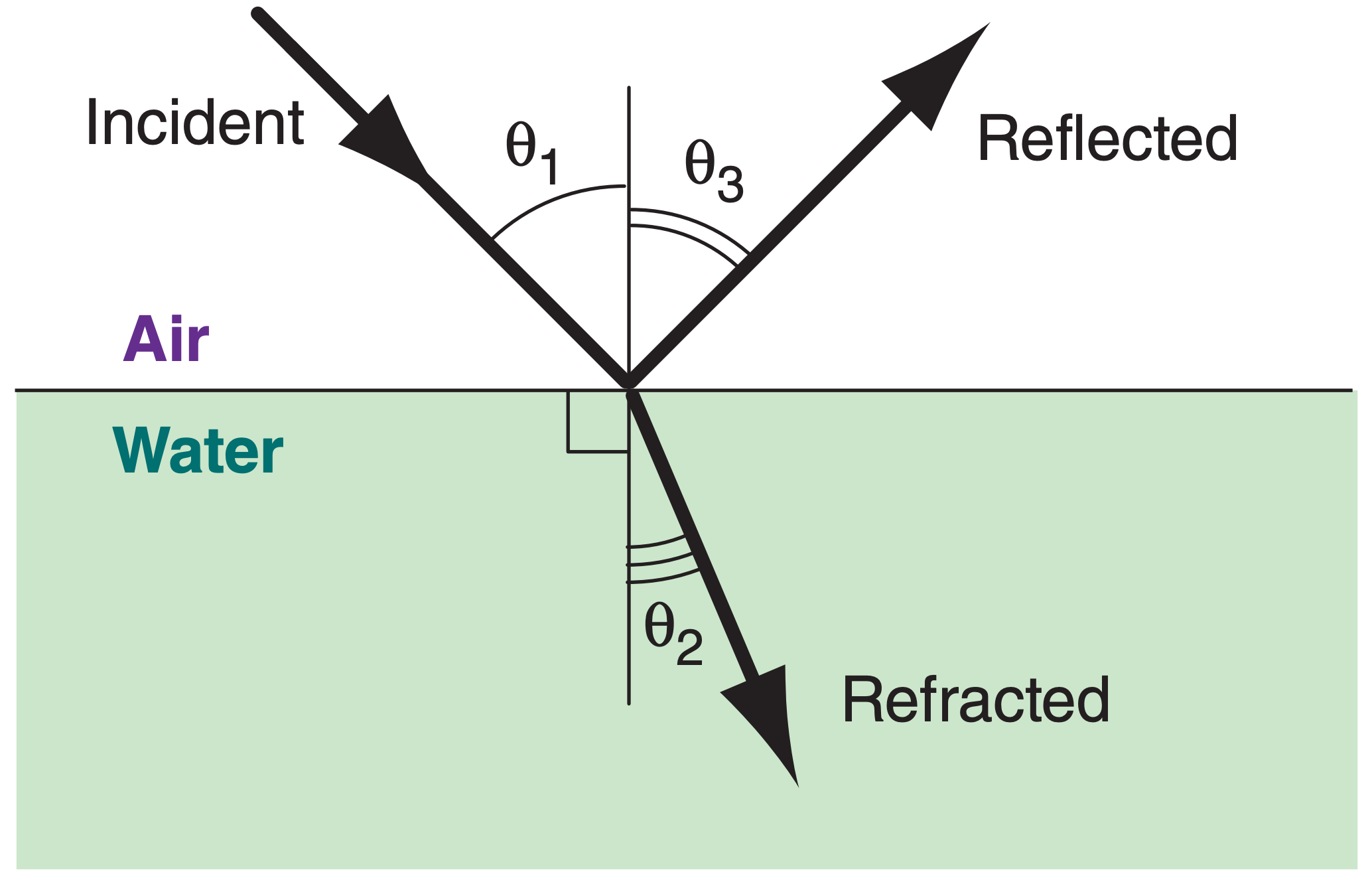
The reflected angle does not depend on color (i.e., is not a function of the wavelength of light).
22.1.2. Refraction
22.1.2.1. Refractive index
The refractive index ni for medium i relative to a vacuum is defined as:
\begin{align}n_{i}=\frac{c_{o}}{c_{i}}\tag{22.2}\end{align}
where ci is the speed of light through medium i and co = 3 x 108 m s–1 is the speed of light in a vacuum.
The ratio of refractive indices is sometimes defined as:
\begin{align}\mu_{12}=\frac{n_{1}}{n_{2}}\tag{22.3}\end{align}
where subscripts 1 and 2 refer to the media containing the incident ray and refracted rays, respectively. Different colors and different media have different refractive indices, as indicated in Table 22-1 and Fig. 22.2.
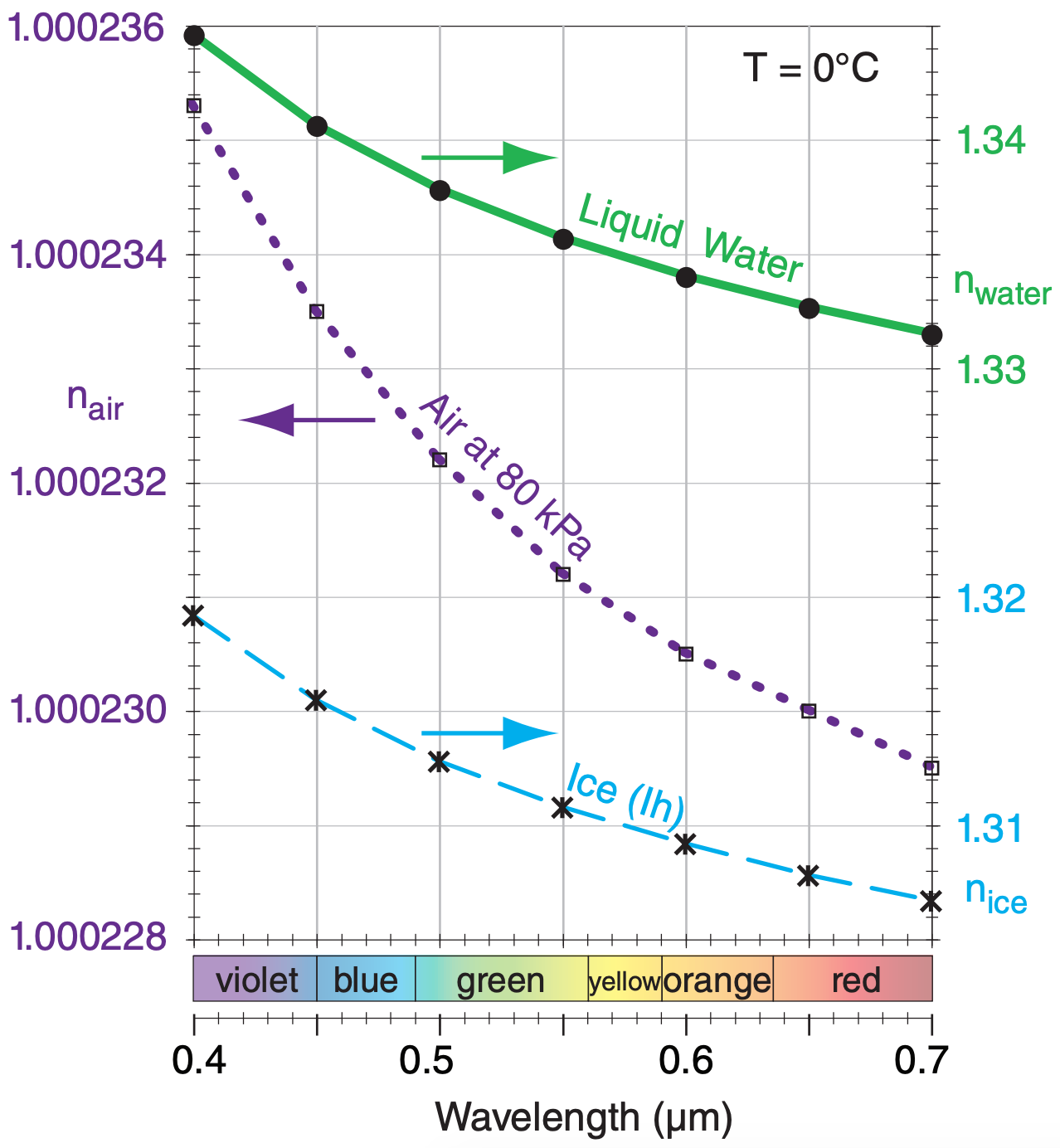
22.1.2.2. Snell’s Law
The relationship between the incident angle θ1 and refracted angle θ2 (Fig. 22.1) is called Snell’s Law:
\begin{align}\frac{\sin \theta_{1}}{\sin \theta_{2}}=\frac{c_{1}}{c_{2}}=\frac{n_{2}}{n_{1}}=\frac{1}{\mu_{12}}\tag{22.4}\end{align}
Incident and refracted rays are always in the same plane. This plane includes the line that is normal to the surface. It is the plane that gives the smallest angle between the incident ray and the surface.
Solving Snell’s Law for the refracted ray angle gives:
\begin{align}\theta_{2}=\arcsin \left[\mu_{12} \cdot \sin \left(\theta_{1}\right)\right]\tag{22.5}\end{align}
Red light is bent less than violet light as it passes through an interface. Thus, refraction causes white light to be spread into a spectrum of colors. This phenomenon is called dispersion.
A viewer looking toward the incoming light ray (Fig. 22.3) would see a light point in the celestial sphere overhead at angle θ2 from normal.
Sample Application
Rays of red and violet light in air strike a water surface, both with incident angle of 60°. Find the angle of refraction for each color, given T = 20°C, P = 101 kPa?
Find the Answer
Given: θ1 = 60° , T = 20°C , P = 101 kPa
Find: θ2 = ?° for red (λ=0.7 µm) and violet (λ=0.4 µm).
Use eq. (22.5): θ2 = arcsin[(n1/n2)·sin(θ1)] = arcsin[ µ12 ·sin(θ1)]
with µ12 from eq. (22.3) and refractive indices from Table 22-1.
For red: µ12 = n1/n2 = 1.0002704/1.3305 = 0.7518
θ2 = arcsin[0.7518·sin(60°)]
θ2 = 40.62°
Similarly for violet: θ2 = 40.15°
Check: Units OK. Physics OK.
Exposition: Had there been no bending, then both answers would have been 60°. Angles closer to 60° for this example correspond to less bending. The answers above confirm the statement that red light is bent less than violet. The amount of bending (difference between incident and refracted angles) is large: 60° – 40° = 20°.
22.1.2.3. Snell’s Law in 3 Dimensions
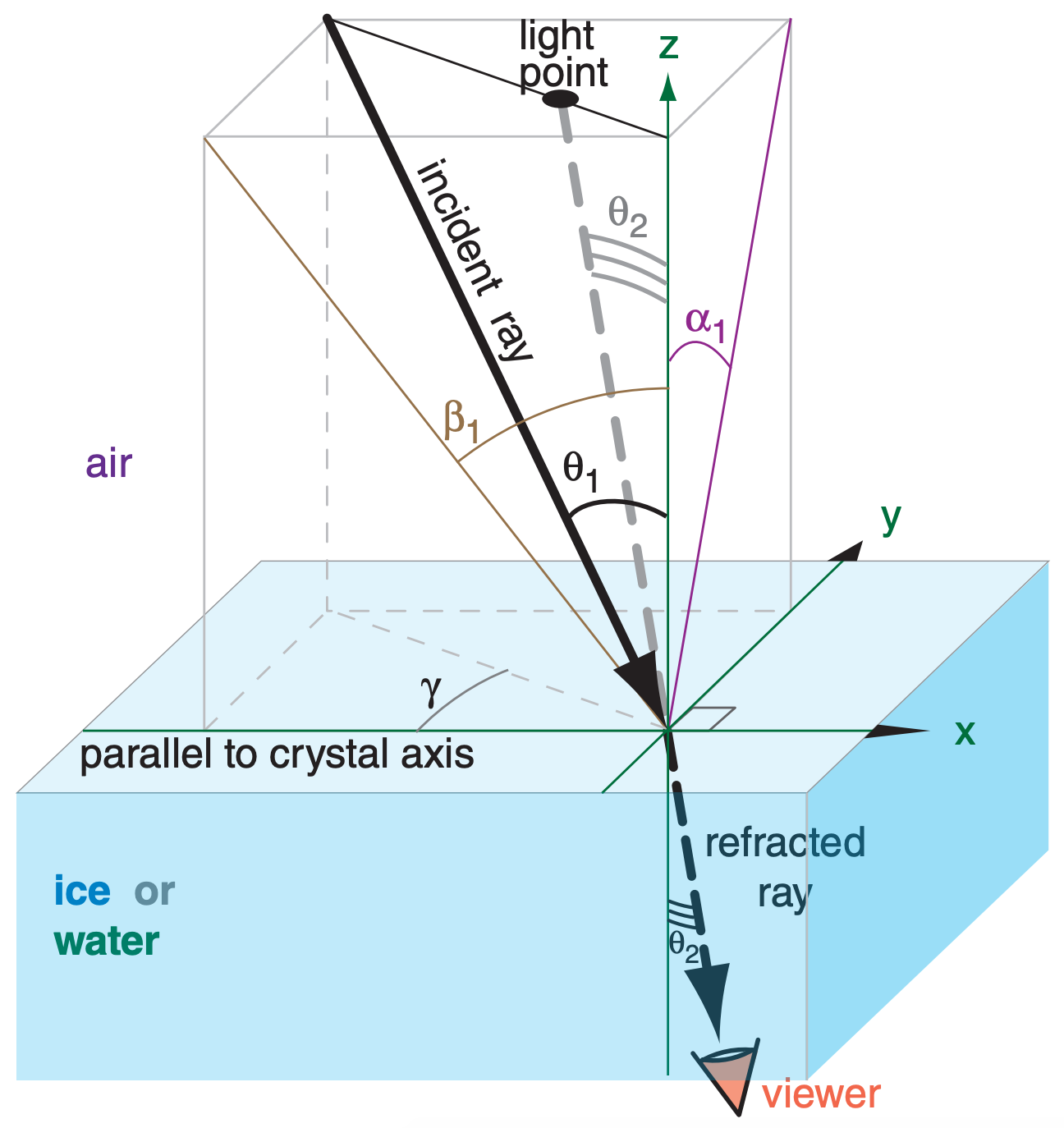
| Table 22-1a. Refractive index (nair) for air with pressure P = 101.325 kPa and relative humidity RH = 75%. From NIST. | |||||
| λ (µm) | Temperature (°C) | ||||
|---|---|---|---|---|---|
| –40 | –20 | 0 | 20 | 40 | |
|
0.4 violet 0.45 |
1.0003496 1.0003469 |
1.0003219 1.0003194 |
1.0002982 1.0002958 |
1.0002773 1.0002751 |
1.0002583 1.0002562 |
|
0.5 0.55 0.6 |
1.0003450 1.0003436 1.0003425 |
1.0003176 1.0003163 1.0003154 |
1.0002942 1.0002930 1.0002921 |
1.0002736 1.0002725 1.0002716 |
1.0002548 1.0002537 1.0002529 |
|
0.65 0.7 red |
1.0003417 1.0003410 |
1.0003146 1.0003140 |
1.0002914 1.0002908 |
1.0002710 1.0002704 |
1.0002523 1.0002523 |
| Table 22-1b. Refractive index (nair) for air with P = 80 kPa and RH = 75%. Based on data from NIST modified Edlen Eq. calculator. | |||||
| λ (µm) | Temperature (°C) | ||||
|---|---|---|---|---|---|
| –40 | –20 | 0 | 20 | 40 | |
|
0.4 violet 0.45 |
1.0002760 1.0002738 |
1.0002541 1.0002521 |
1.0002353 1.0002335 |
1.0002188 1.0002171 |
1.0002036 1.0002019 |
|
0.5 0.55 0.6 |
1.0002723 1.0002712 1.0002704 |
1.0002507 1.0002497 1.0002489 |
1.0002322 1.0002312 1.0002305 |
1.0002158 1.0002150 1.0002143 |
1.0002008 1.0001999 1.0001993 |
|
0.65 0.7 red |
1.0002697 1.0002692 |
1.0002483 1.0002479 |
1.0002300 1.0002295 |
1.0002138 1.0002134 |
1.0001988 1.0001984 |
| Table 22-1c. Refractive index (nair) for air with P = 40 kPa and RH = 75%. Based on data from NIST modified Edlen Eq. calculator. | |||||
| λ (µm) | Temperature (°C) | ||||
|---|---|---|---|---|---|
| –40 | –20 | 0 | 20 | 40 | |
|
0.4 violet 0.45 |
1.0001379 1.0001369 |
1.0001270 1.0001260 |
1.0001176 1.0001166 |
1.0001091 1.0001082 |
1.0001009 1.0001000 |
|
0.5 0.55 0.6 |
1.0001361 1.0001355 1.0001351 |
1.0001253 1.0001248 1.0001244 |
1.0001160 1.0001155 1.0001151 |
1.0001076 1.0001071 1.0001068 |
1.0000994 1.0000990 1.0000987 |
|
0.65 0.7 red |
1.0001348 1.0001346 |
1.0001241 1.0001239 |
1.0001149 1.0001147 |
1.0001066 1.0001064 |
1.0000985 1.0000983 |
| Table 22-1d. Refractive index (nwater) for liquid water. Based on data from IAPWS 1997 release and CRC Handbook. | |||||
| λ (µm) | Temperature (°C) | ||||
|---|---|---|---|---|---|
| –40 | –20 | 0 | 20 | 40 | |
|
0.4 violet 0.45 |
(values below 0°C are for supercooled water) |
1.3429 1.3390 |
1.3446 1.3406 |
1.3436 1.3396 |
1.3411 1.3371 |
|
0.5 0.55 0.6 |
1.3362 1.3341 1.3324 |
1.3378 1.3357 1.3340 |
1.3368 1.3347 1.3330 |
1.3344 1.3323 1.3306 |
|
|
0.65 0.7 red |
1.3310 1.3299 |
1.3326 1.3315 |
1.3317 1.3305 |
1.3293 1.3281 |
|
| density (kg m–3): | 993.547 | 999.840 | 998.207 | 992.200 | |
| Table 22-1e. Refractive index (nice) for ice (Ih). Based on data from S.G. Warren (1984) and V.F. Petrenko & R.W. Whitworth (1999). | |||||
| λ (µm) | Temperature (°C) | ||||
|---|---|---|---|---|---|
| –40 | –20 | 0 | 20 | 40 | |
|
0.4 violet 0.45 |
1.3206 1.3169 |
1.3199 1.3162 |
1.3192 1.3155 |
(values at 0°C were extrapolated) (See INFO Box in Precipitation chapter for info on ice phases such as Ih.) |
|
|
0.5 0.55 0.6 |
1.3142 1.3122 1.3106 |
1.3135 1.3115 1.3099 |
1.3128 1.3108 1.3092 |
||
|
0.65 0.7 red |
1.3092 1.3081 |
1.3085 1.3074 |
1.3078 1.3067 |
||
Sometimes it is easier to work with x and y components of the incident ray, where the x-axis might be aligned with the axis of a columnar ice crystal, for example, and the y-axis might be on the crystal prism surface (Fig. 22.3). The relationship between the component angles and the incident angle is:
\begin{align}\tan ^{2} \theta_{1}=\tan ^{2} \alpha_{1}+\tan ^{2} \beta_{1}\tag{22.6}\end{align}
where θ, α and β are as illustrated in Fig. 22.3. This relationship also applies to refracted angles (θ2, α2, β2), and will be used extensively later in this chapter to discuss ice-crystal optics.
Sample Application
Find the speed of red light through liquid water and through air at T = 20°C and P = 101.325 kPa.
Find the Answer
Given: λ = 0.7 µm, T = 20°C and P = 101.325 kPa.
Find: cair = ? m s–1 , cwater = ? m s–1.
Use eq. (22.2) with refractive indices from Table 22-1:
cair = co/nair =(3x108m s–1)/1.0002704 =2.999x108 m s–1
cwater = co/nwater =(3x108m s–1)/1.3305 =2.255x108 m s–1
Check: Speeds reasonable. Units OK.
Exposition: The difference in speeds of light is useful for understanding Huygens’ principle.
Component angles α and β of the refracted and incident rays do NOT individually obey Snell’s law (eq. 22.4). Nevertheless, Snell’s law can be reformulated in terms of components as follows:
\begin{align}\tan ^{2} \alpha_{2}=b_{\alpha \beta} \cdot \tan ^{2} \alpha_{1}\tag{22.7a}\end{align}
\begin{align}\tan ^{2} \beta_{2}=b_{\alpha \beta} \cdot \tan ^{2} \beta_{1}\tag{22.7b}\end{align}
where α2 and β2 are the components of the refracted ray (analogous to α1 and β1), and
\begin{align}b_{\alpha \beta}=\frac{\mu_{12}^{2}}{1+\left(1-\mu_{12}^{2}\right) \cdot\left\{\tan ^{2} \alpha_{1}+\tan ^{2} \beta_{1}\right\}}\tag{22.8}\end{align}
These equations are abbreviated as
\begin{align}\alpha_{2}=S_{\alpha}\left(\alpha_{1}, \beta_{1,}, \mu_{12}\right)=\arctan \left[\left(b_{\alpha \beta} \cdot \tan ^{2} \alpha_{1}\right)^{1 / 2}\right]\tag{22.9b}\end{align}
\begin{align}\beta_{2}=S_{\beta}\left(\alpha_{1}, \beta_{1,}, \mu_{12}\right)=\arctan \left[\left(b_{\alpha \beta} \cdot \tan ^{2} \beta_{1}\right)^{1 / 2}\right]\tag{22.9b}\end{align}
where S represents Snell’s law for components.
Sample Application
A ray of red light in air strikes a water surface, with incidence angle components of α1 = 45° and β1 = 54.74°. What are the corresponding component angles of the refracted ray? Assume T = 20°C and P = 101.325 kPa.
Find the Answer
Given: α1 = 45°, β1 = 54.74°.
Find: α2 = ?° , β2 = ?°
From Table 22-1 for red light:
µ122 = (1.0002704/1.3305)2 = (0.7518)2 = 0.5652
Also: tan(45°) = 1, and tan(54.74°) = 1.414
Next, solve eq. (22.8):
\(\ b_{\alpha \beta}=\frac{0.5652}{1+(1-0.5652) \cdot(1+2)}=0.2453\)
Then use eqs. (22.7):
tan2(α2) = 0.2453·[tan2(45°)] = 0.2453
tan2(β2) = 0.2453·[tan2(54.74°)] = 0.4906
Thus: α2 = arctan[(0.2453)0.5] = 26.35°
β2 = arctan[(0.4906)0.5] = 35.01°
Check: Units OK. Physics OK.
Exposition: Using eq. (22.6) with the incident angle components of 45° and 54.74°, we find that the incident ray angle is θ1=arctan[(1+2)0.5] = 60°. This is the same as a previous Sample Application. Using eq. (22.6) on the answers above, we find θ2 = arctan[ (0.2453+0.4906)0.5] = 40.62°. This is also the same as a previous Sample Application, which verifies eqs. (22.6 - 22.9).
22.1.3. Huygens’ Principle
Huygens suggested that every point along a wave front acts like a generator of new spherical secondary wavelets. Wave-front position after some time interval is located at the tangent to all of the new wavelets. Thus, when a portion of a wave front encounters a medium with a slower light velocity, then that portion of the wave slows, causing the whole wave front to turn into the medium (Fig. 22.4).
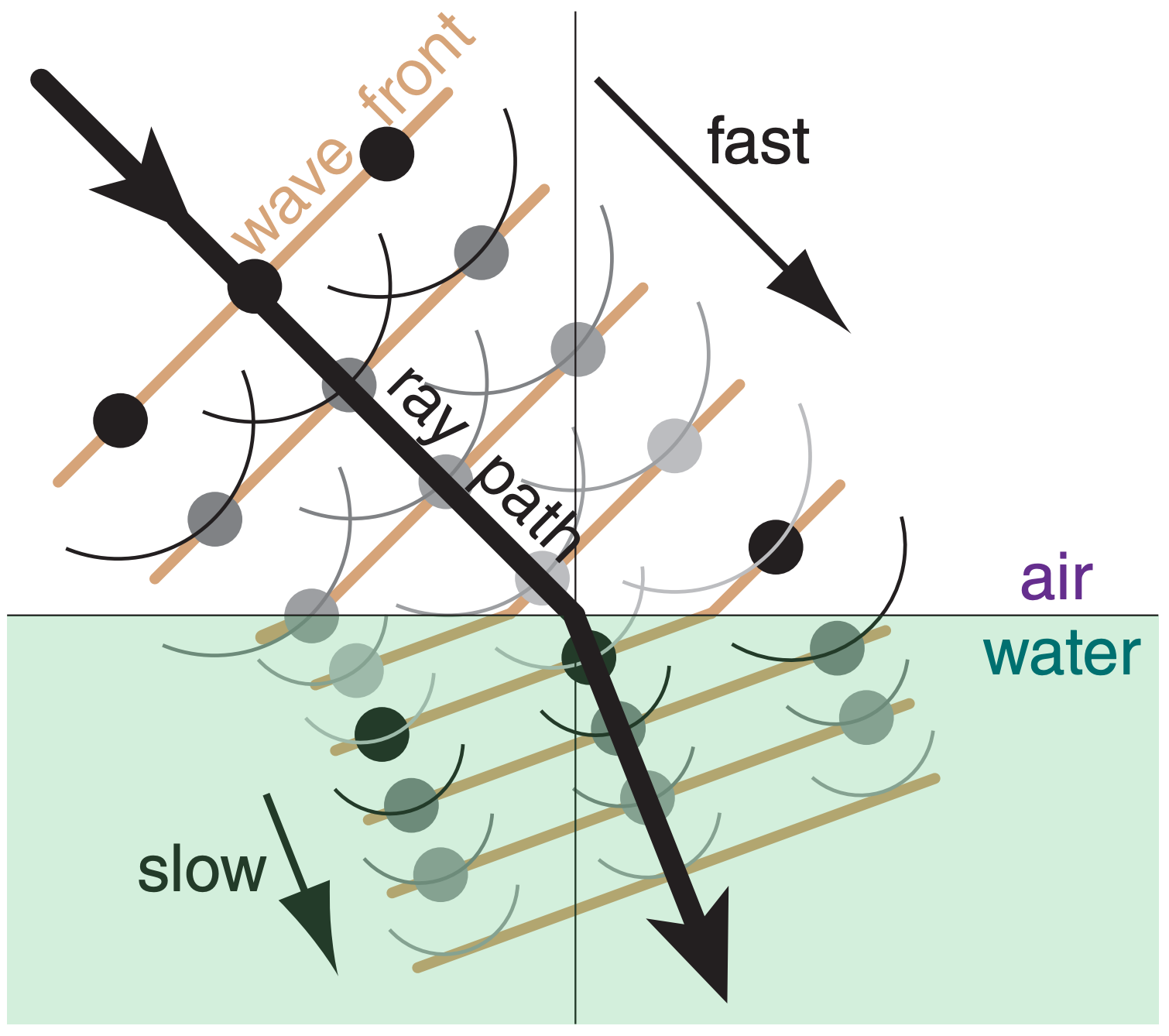
22.1.4. Critical Angle
When Snell’s law is applied to light rays moving from a denser medium (having slower light velocity) to a less-dense medium (having faster light velocity), there is a critical angle at which light is bent so much that it follows the interface. At angles greater than this critical incidence angle, light cannot refract out of the dense medium at all. Instead, all of the light reflects (Fig. 22.5).
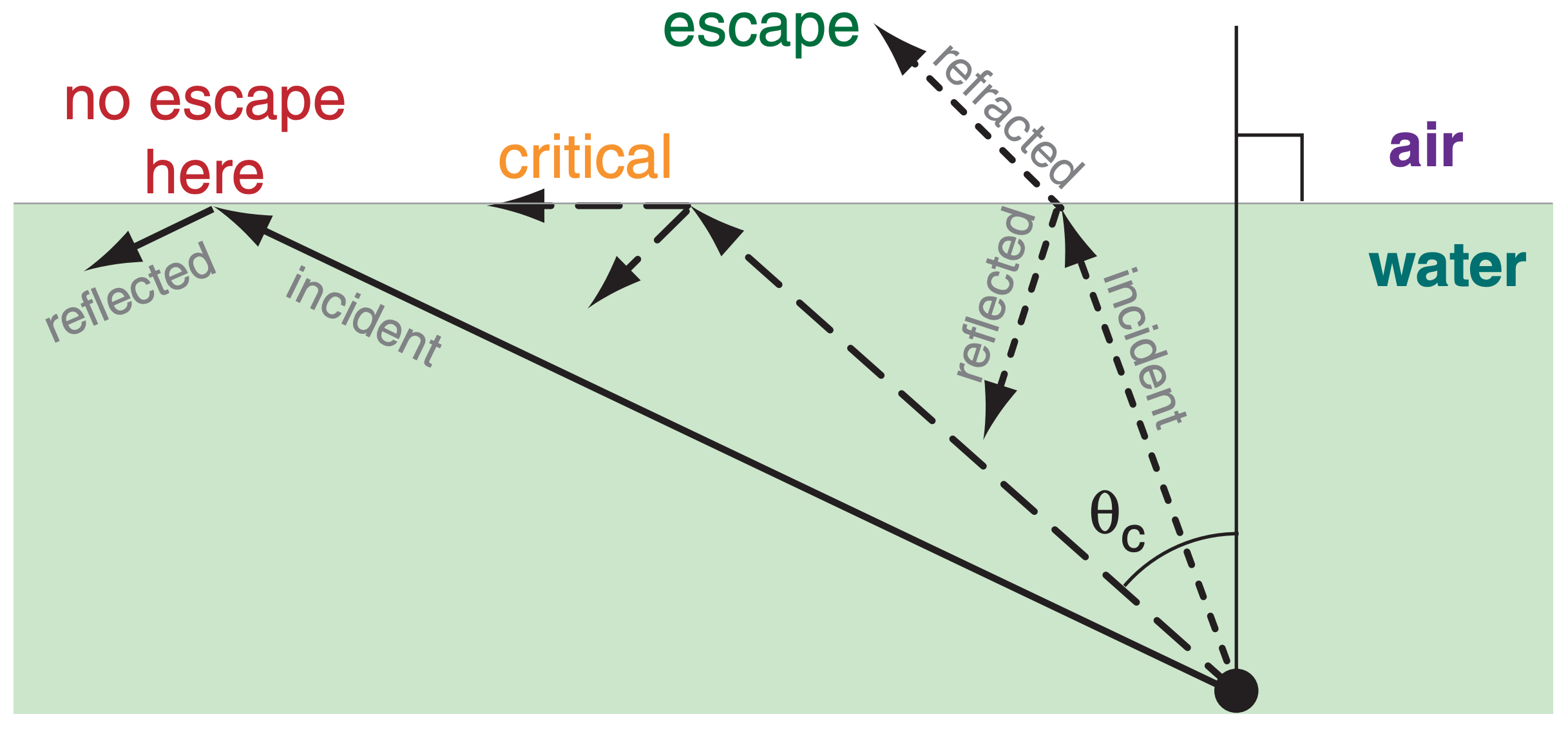
The critical angle θc is found from:
\begin{align}\sin \left(\theta_{c}\right)=\frac{n_{2}}{n_{1}}\tag{22.10}\end{align}
where n1 is the refractive index for the incident ray (i.e., in the denser medium with slower light velocity). An example is a light ray moving out of water and into air (i.e., n2 < n1). For red light the critical angle is about 48.7°, while for violet light the it is about 48.1°. There is no critical angle for light moving into a denser medium (i.e., n2 > n1).
Sample Application
Find the critical angle for red light going from a cirrus-cloud ice crystal to air, where the air state is T = –20°C & P = 40 kPa.
Find the Answer
Given: red light λ = 0.7 µm, T = –20°C & P = 40 kPa.
Find: θc = ? °
From Table 22-1: nice = 1.3074 and nair = 1.0001239.
Use eq. (22.10):
θc = arcsin(1.0001239/1.3074) = 49.9°.
Check: Magnitude OK. Units OK.
Exposition: This critical angle is close to that for liquid water, because the refractive indices for liquid and solid water are nearly the same.


